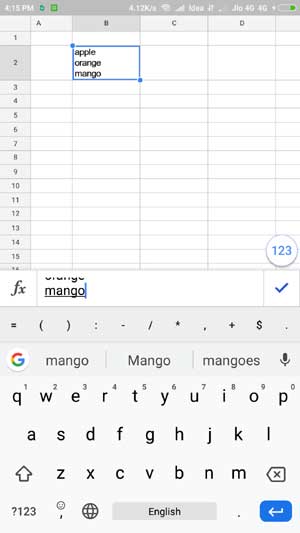To start text on new lines within a cell in Google Sheets, you need to know how to add line breaks (carriage returns) in cells. This process differs between the desktop browser version and mobile apps.
I recently explained how to create a table using values within new lines in cells. If you missed that topic, you can read it here: How to Move New Lines in a Cell to Columns in Google Sheets.
In that tutorial, I covered how to start new lines within a cell on the browser version of Google Sheets, not on Google Sheets for Android or iOS.
Starting New Lines within a Cell in Google Sheets
The method varies between Google Sheets mobile apps and desktop browsers.
On Google Sheets Mobile Apps
Step 1:
Enter any text string in a cell.
If you want to insert a line break in existing content, navigate to the cell containing the text, double-tap to edit the content. Then, move the cursor to the position where you want to insert the line break.
Step 2:
In the second step, tap on the cursor position and select “Insert line break” from the inline editing menu.
This method allows you to insert as many new lines as you want in your Google Sheets Android or iOS mobile apps.

On Google Sheets Desktop Browser Version
Unlike mobile apps, the inline editing menu within cells on the desktop browser versions of Google Sheets doesn’t have the “insert line break” option. Instead, you need to use Google Sheets keyboard shortcuts to insert new lines within cells.
Step 1:
Type the text content in a cell, or double-click to edit the existing cell content and navigate to the position where you want to insert the line break.
Step 2:
If you are using a Mac, use the shortcut Option + Return. On Windows, press Alt + Enter.
Note: If you check the Docs Editors Help for keyboard shortcuts, you will notice that the above shortcuts are assigned to open hyperlinks. Please don’t get confused. It works like this:
If you navigate to a cell containing a hyperlink, using the above shortcut will open the hyperlink in a new tab. In editing mode, it inserts a carriage return.
Can I Use Carriage Returns in Formulas
Yes! You can use CHAR(10) in formulas to force line breaks.
The following CHAR formula will place the strings “Apple”, “Orange”, and “Banana” in three lines within a cell:
="Apple"&CHAR(10)&"Orange"&CHAR(10)&"Banana"Pros and Cons of Using New Lines in Cells
New lines within a cell serve several purposes. Here are a few of them:
- You can start a new line to add related information, such as a name in the first line and addresses in the next few lines. This keeps them together when sorting or filtering.
- New lines can be used to separate different pieces of information within a cell, making it easier to distinguish between them.
- You can break long sentences at the position you want.
What are their disadvantages?
- You can’t sort the information within a single cell using the SORT function. This might require finding workarounds that may not be straightforward for beginners.
- Line breaks can cause issues in data manipulations. For example, if “Apple” is in the first line and “Grade A” is in the second line within cell A1, and cell A2 contains “Apple,” when you group A1:A2 using QUERY or PIVOT table, these values will not group together.
- Similar issues may arise when using lookups without wildcards.
- Excessive use of line breaks can cause readability issues due to cluttering of information.





















